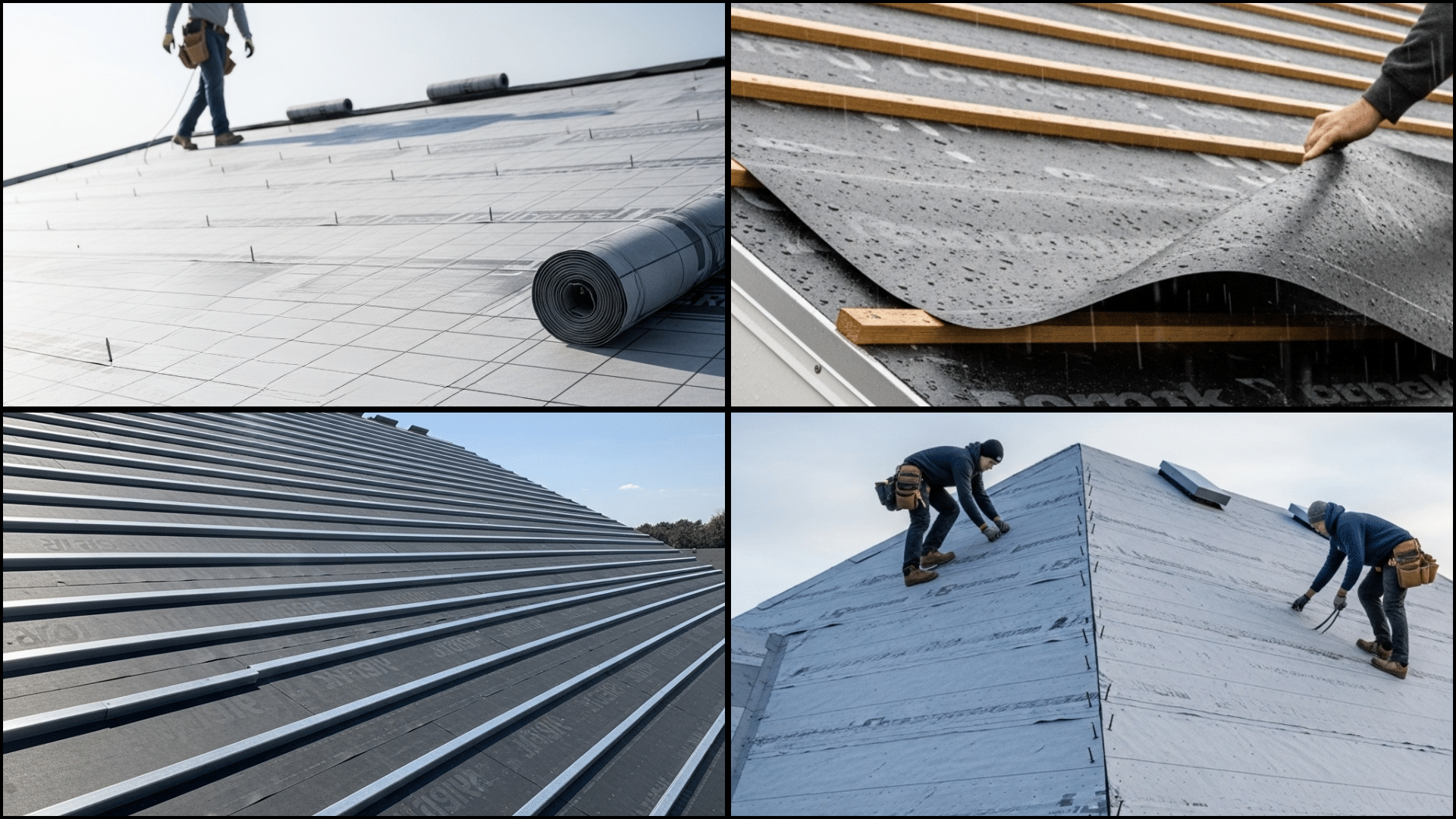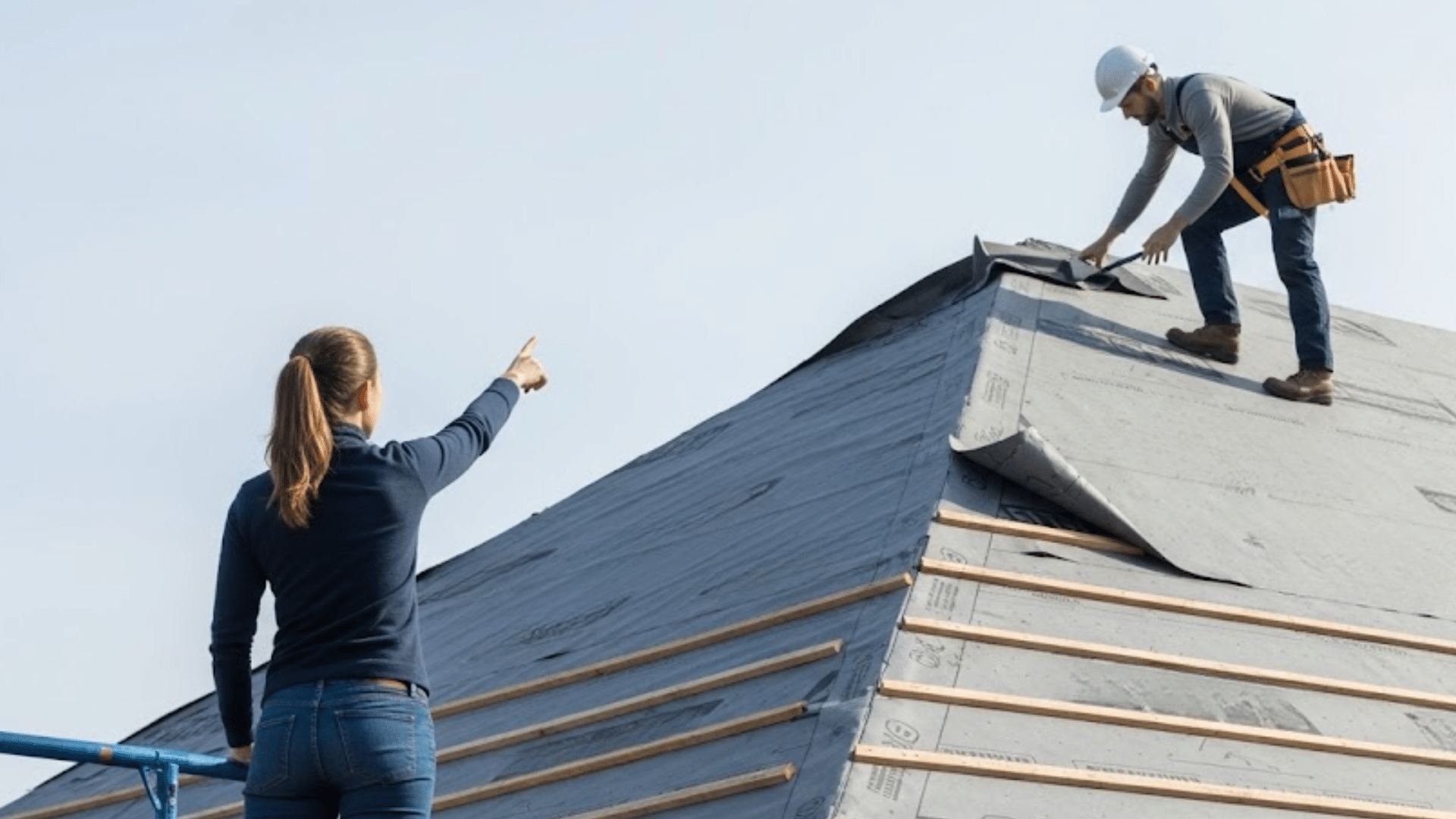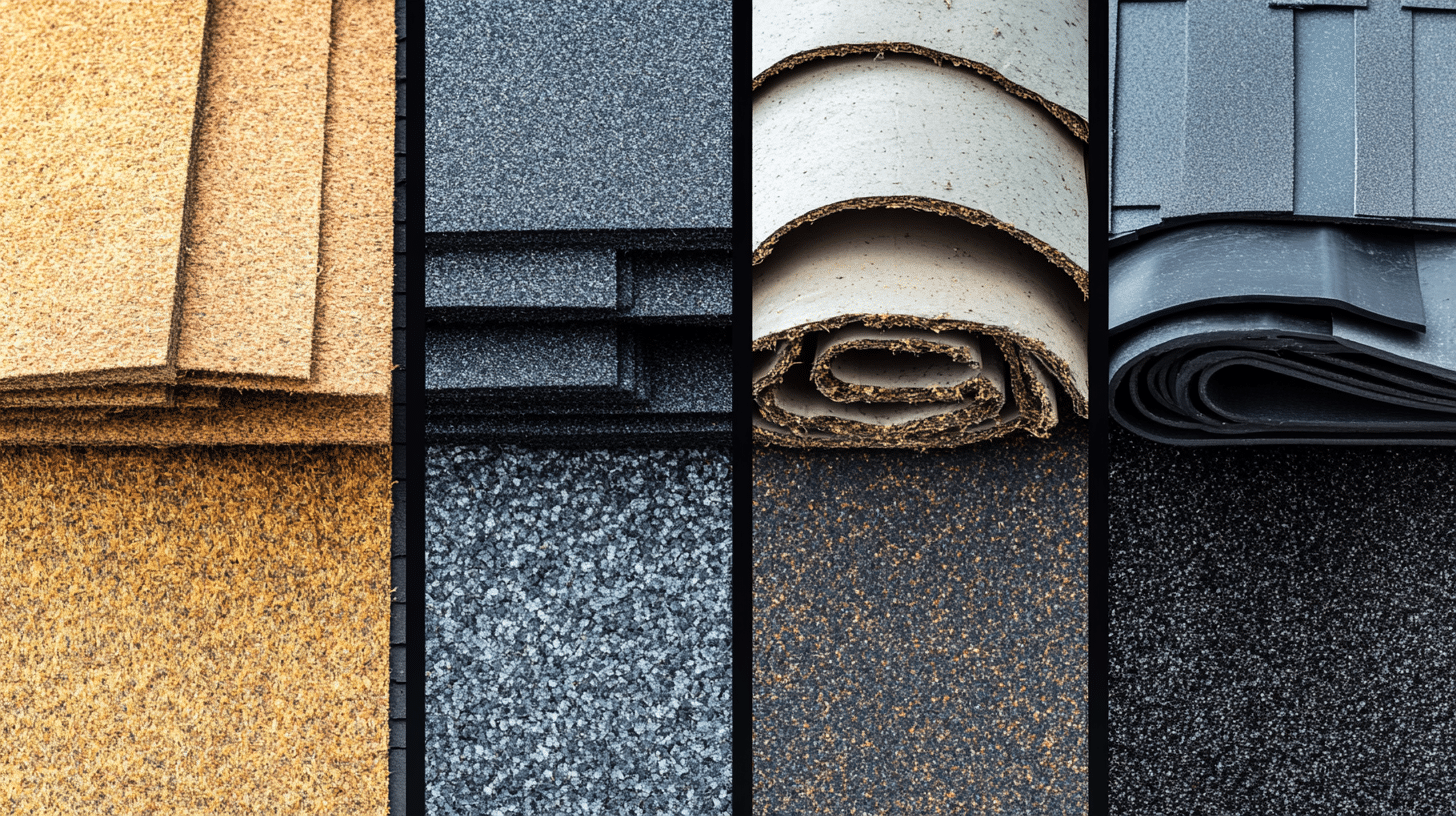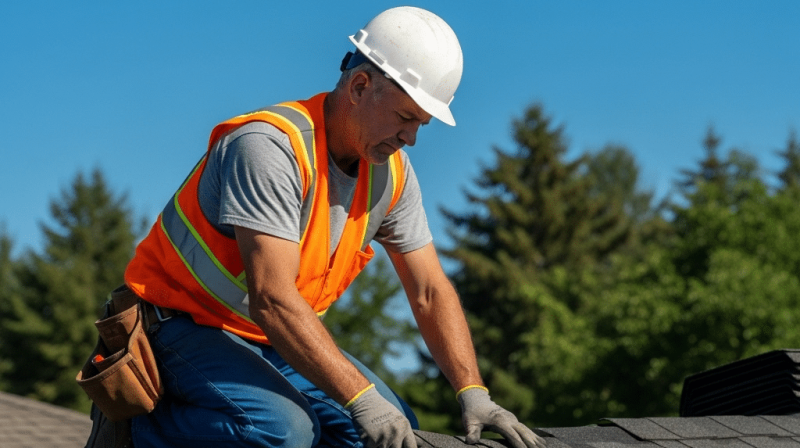Last month, my neighbor’s brand-new roof started leaking. The contractor had used synthetic roof underlayment, which was intended to be superior to traditional felt.
However, the issue is that synthetic underlayment can cause significant problems if you’re unaware of the potential issues to watch for.
In this post, I’ll share the most common problems with synthetic roof underlayment that I’ve seen firsthand. We’ll cover what goes wrong, why it happens, and how to fix each issue.
By the end, you’ll know exactly what to look for and how to avoid these costly mistakes on your own roof project.
What is Synthetic Roof Underlayment
Synthetic roof underlayment is a modern alternative to traditional felt paper, which is placed between the roof deck and shingles. Think of it as a protective barrier that keeps water out if your shingles get damaged or blown off during storms.
Unlike traditional tar paper made from organic materials, synthetic underlayment utilizes plastic polymers, essentially engineered plastics that resist tearing and water damage. The most common types are made from polypropylene or polyethylene materials that look like fabric but feel much stronger.
Traditional felt paper can absorb water and break down over time, but Synthetic versions don’t absorb moisture at all. They’re also lighter weight, which makes installation easier for roofers.
The main difference is that Synthetic underlayment costs more upfront but lasts much longer. While felt paper might last 15-20 years, quality synthetic options can protect your roof for 25-30 years or more.
Choosing the Right Synthetic Roof Underlayment

Not all synthetic underlayments are created equal. Each type serves different purposes and works better in specific situations.
Understanding these differences helps you pick the right one for your roof project. Let me break down the four main types you’ll encounter:
1. Non-bitumen synthetic underlayment (polypropylene or polyethylene-based): This is the most common type. Made from woven or non-woven plastic fibers, it’s lightweight and tear-resistant. It doesn’t contain any asphalt, making it safer to walk on and less likely to stick to your roof deck.
2. Self-adhered synthetic underlayment: This type has a sticky back that bonds directly to your roof deck without nails. It creates a watertight seal around nail holes and works great in areas prone to ice dams or heavy rain.
3. High-temperature rated synthetic underlayment: Built to handle extreme heat from metal roofing or tile installations. Regular synthetic can melt under high temperatures, but this version stays stable even when things get hot.
4. Breathable synthetic underlayment: Allows moisture vapor to escape from your attic while keeping liquid water out. This prevents condensation buildup that can cause mold and rot issues.
Problems with Synthetic Roof Underlayment & How to Solve Them

Even the best roofing materials have their downsides, and synthetic underlayment is no exception. I’ve seen contractors and homeowners repeatedly encounter the same problems with synthetic roof underlayment.
Fortunately, most of these problems have straightforward fixes. Here are the most common problems you’ll face and how to handle each one.
1. Slippery Surface During Installation
Synthetic underlayment becomes extremely slippery when wet, creating safety risks for roofers. This smooth surface can cause dangerous falls during installation.
Solution: Install during dry weather conditions and use proper safety equipment like harnesses and non-slip shoes. Some contractors apply temporary sand strips for better traction during wet conditions.
2. Higher Upfront Cost
Synthetic underlayment costs 2-3 times more than traditional felt paper, making it expensive for budget-conscious projects. This higher price can strain construction budgets.
Solution: Consider the long-term value – synthetic lasts 10+ years longer than felt. Calculate total cost over the roof’s lifetime, not just initial expense. The durability often justifies the higher upfront investment.
3. UV Exposure Limitations
Extended UV exposure breaks down synthetic materials, causing them to become brittle and lose effectiveness. Most types shouldn’t stay exposed for more than 6 months.
Solution: Install final roofing materials quickly after underlayment installation. Use UV-resistant synthetic options if longer exposure is expected. Cover exposed areas with tarps during construction delays.
4. Moisture Trapping and Ventilation Problems
Non-breathable synthetic underlayment can trap moisture in your attic, leading to condensation, mold growth, and wood rot in the roof structure.
Solution: Choose breathable synthetic underlayment or ensure proper attic ventilation with ridge and soffit vents. Install vapor barriers correctly and maintain good air circulation in the attic space.
5. Compatibility Problems with Roofing Materials
Some synthetic underlayments don’t work well with certain shingle types or metal roofing, causing adhesion problems or chemical reactions that damage materials.
Solution: Check manufacturer compatibility charts before purchase. Ask your roofing supplier which synthetic products work best with your chosen roofing material. Test small areas first if unsure about compatibility.
6. Limited Insulation Value
Synthetic underlayment offers minimal thermal insulation compared to some traditional options, which may impact your home’s energy efficiency.
Solution: Don’t rely on underlayment for insulation. Install proper attic insulation separately. Focus on the underlayment’s primary job, water protection, and handle insulation through dedicated materials.
7. Environmental Concerns
Synthetic materials don’t break down naturally and can contribute to landfill waste. The manufacturing process also uses petroleum-based products.
Solution: Look for recyclable synthetic options or consider eco-friendly alternatives. Some manufacturers offer take-back programs. Balance environmental concerns with performance needs and local climate requirements.
8. Warranty Restrictions
Many roofing warranties require specific types of underlayment or specific installation methods. Using the wrong synthetic product can void your shingle warranty completely.
Solution: Read warranty requirements carefully before purchasing. Use manufacturer-approved underlayment products. Keep installation documentation and receipts. Follow all specified installation procedures to maintain warranty coverage.
9. Durability in Extreme Weather
High winds can lift and tear synthetic underlayment, while extreme temperature changes can cause issues with expansion and contraction.
Solution: Use proper fastening patterns with correct nail spacing. Select heavier-weight synthetic products for areas with high winds. Install expansion joints in large roof sections to accommodate temperature movement.
How To Correctly Install Synthetic Roof Underlayment?
Getting the installation right makes all the difference between a roof that protects your home for decades and one that fails within a few years.
Proper installation isn’t complicated, but it does require attention to detail and following the right steps:
- Prepare the roof deck thoroughly by cleaning off all debris, old nails, and rough spots. Check for any damaged or loose boards and fix them before starting.
- Ensure proper overlap and alignment of sheets with at least 6 inches of overlap at horizontal seams and 4 inches at vertical seams. Keep rows straight and parallel to prevent water from finding gaps between sheets.
- Use manufacturer-recommended fasteners spaced according to their specifications, typically every 12-16 inches along edges. Wrong fasteners or poor spacing can cause the material to pull away during storms.
- Seal seams and edges as directed using approved tape or sealant. Pay extra attention to valleys, ridges, and around roof penetrations where water likes to collect.
- Avoid prolonged UV exposure before final roofing by installing shingles within the recommended timeframe, usually 30-180 days, depending on the product.
Top Alternatives to Synthetic Roof Underlayment

Sometimes, synthetic underlayment may not be the right fit for your project. Perhaps the cost is too high, or you’re experiencing problems with synthetic roof underlayment, or you prefer traditional materials.
In that case, you have several solid options that can protect your roof just as well. Let me walk you through the most popular alternatives and when each one makes the most sense for your situation.
| Underlayment Type | Water Resistance | Durability | Cost | Installation Ease | UV Resistance | Best For |
|---|---|---|---|---|---|---|
| Synthetic Roof Underlayment | Water-resistant | High | Moderate | Easy | Moderate–High | Most modern roofs |
| Traditional Roof Underlayment | Water-resistant | Moderate | Low | Moderate | Low | Budget or basic applications |
| Asphalt-Saturated Felt | Water-resistant | Moderate | Low | Moderate | Low | Traditional residential roofing |
| Fiberglass Reinforced Felt | Water-resistant | Higher than felt | Moderate | Moderate | Moderate | Enhanced durability needs |
| Rubberized Asphalt Underlayment | Waterproof | Very High | High | Easy | High | Low-slope or leak-prone roofs |
| Peel and Stick Roof Underlayment | Waterproof | High | High | Easy | High | Ice/water-prone areas |
How to Choose the Right Roofing Materials to Avoid Common Problems
Making the right material choices upfront saves you from headaches later. I’ve seen too many homeowners pick the cheapest option only to face expensive repairs within a few years.
Smart material selection isn’t just about price. It’s about matching products to your specific needs and local conditions.
Here’s how to make choices that protect your investment:
- Prioritize proper installation techniques by hiring certified professionals: Look for contractors with manufacturer certifications and good local references. Proper installation matters more than the brand you choose.
- Select an underlayment compatible with your roofing material and climate: Metal roofs need a different underlayment than asphalt shingles. Cold climates require different specs than hot, dry areas.
- Compare quality ratings and warranties among leading brands: Don’t just compare prices. Consider the warranty length, what is covered, and the company’s reputation for honoring claims.
- Consult expert recommendations for underlayment and roofing combinations: Ask your supplier which products work best together. Some combinations perform better than others.
- Ensure adequate attic ventilation to prevent moisture issues: Poor ventilation causes more problems than bad underlayment. Install proper intake and exhaust vents.
- Review manufacturer guidelines for exposure and installation: Follow the instructions exactly. Shortcuts void warranties and cause premature failure.
Final Verdict
Now you know the common problems with synthetic roof underlayment and how to fix each one.
You don’t have to make the same mistakes. Even when you’re planning a new roof or addressing existing issues, you now have the knowledge to make informed decisions.
Before you start any roofing project, review these issues with your contractor. Make sure they understand proper installation techniques and material compatibility.
Have you dealt with any of these synthetic underlayment problems on your own roof?







